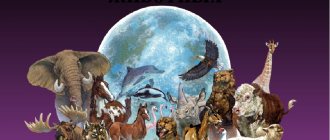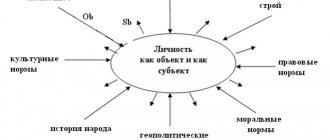Definition of personality in different sciences
In sociology, the concept of personality is studied in the process of relationships between people, as well as as a separate element of the social system. In addition, sociology conducts the study of personality when it is still being formed, in the process of its formation and the acquisition by an individual of certain qualities characteristic only of him. In contrast to legal science, which looks at this as a completely ready-made and formed concept.
In jurisprudence, a person is understood as an individual who has certain rights, freedom of action and obligations as an ordinary person and as a citizen in general. This concept refers to the personality of a specific person who has a number of socially important qualities that manifest themselves in relationships with other people.
Biological in man
From the point of view of anatomy and physiology, man is the most common biological creature. Each of the systems present in our body solves certain biological problems. For example, the circulatory system provides all organs with oxygen and nutrients, and the lymphatic system ensures their cleansing.
We are completely dependent on the state of these systems, so we must constantly maintain them. We need to sleep, eat, and satisfy other physiological needs. Nevertheless, sometimes we get sick, and then the whole body begins to “fail.” But soon the immune system copes with the disease, and all systems work as usual again. All these processes are purely biological , and occur in us in exactly the same way as in most warm-blooded animals.
Interestingly, many of our systems are inferior in their capabilities to similar animal systems. Our eyesight cannot compare to that of an eagle, we cannot run as fast as a cheetah, and our stomachs cannot digest grass into nutrients the way a cow's stomach can. Nevertheless, in our overall potential we are superior to all animals, and this is ensured precisely by our social nature.
Basic approaches to studying personality
There are many different theories of personality in the social sciences. Among them, the following main approaches can be distinguished:
- Dialectical-materialistic approach , according to which the personality develops according to a dialectical process determined by the following factors: the origin of the individual, the society surrounding him, upbringing and self-education skills. From the very beginning, a person is considered a social being, his personality is formed in the process of interaction with society, that is, when a person interacts with the world around him in the process of his formation and self-awareness.
- Anthropological approach . In this approach, the concept of personality is perceived as the bearer of the characteristic properties of all humanity. Personality is equated with the individual. This approach compares the understanding of personality, person and individual. He ignores the fact that the social environment plays an important role in shaping personality.
- Normative approach . According to this approach, the concept of personality is associated with the acquisition of good qualities that relate to a person's consciousness and actions.
- Sociological approach . Its essence lies in the fact that every person is an individual, regardless of his socially significant characteristics. The concept of personality in this approach is considered as an object and products of relations with society.
- Personal approach . In contrast to the anthropological and sociological approach, this concept makes it possible to understand personality as an individual and unique organism independent of any factors.
- Biological-genetic approach . According to this approach, it is believed that such behavior in people is embedded in their genes. What can be considered primitive determinism. This approach neglects the importance of social conditions and cultural heritage in the formation of an individual in society.
Examples of biological features
Man differs from other animals in many biological features. The most important and clearly visible signs include:
- Developed hands. Humans have very well developed hands, which allows them to be used in a variety of ways. Like other primates, they are very tenacious and quite strong. This allows you to pick up heavy objects and do rough work. But what makes a person unique is his developed fine motor skills, which allow him to also perform very delicate work.
- Upright walking. Many animals can stand on their hind legs or even walk on them. But only for humans, upright walking is the main type of movement.
- Reduced hairline. Since man has been protecting himself from the cold with clothing for many millennia, there is practically no hair left on his body. Interestingly, this trait is not unique, and many marine mammals also do not have hair.
- Developed brain. Humans have the highest encephalization coefficient (a measure of the ratio of brain mass to body mass) of all animals. In an adult of average build it is approximately 7.3-7.8. The second step in this “rating” is occupied by bottlenose dolphins (a genus of dolphins) with an encephalization coefficient of 5.4.
- Speech. The ability to speak clearly, pronouncing complex combinations of sounds, is a unique feature of humans, distinguishing them from all mammals. Interestingly, some birds are able to learn to “speak.” However, the speech of birds has a different nature - they have a well-developed ability to imitate sounds. That is, they do not utter meaningful phrases, but imitate any sounds in general (for example, parrots often imitate other domestic animals).
Personality structure
When studying and analyzing personality as a complex social phenomenon of society, it is important to highlight its structure, which is based on the following elements:
- biological level : it includes natural qualities inherent to all humanity (anatomical structure of the body, gender, character, etc.);
- psychological level : includes the psychological state of the individual such as the manifestation of feelings, freedom of choice, memories, way of thinking. Such features are closely related to hereditary personality traits;
- The social level is usually divided into the following sublevels:
- The sociological proper determines a person’s behavior in society, as well as his personal interests and pursued goals.
- Cultural-specific shows personal values, as well as behavioral factors corresponding to the norms of society.
- The moral sublevel demonstrates the moral qualities of a person, which he is guided by in any of his choices.
Social in man
Man is the only representative of the animal world who does not adapt to the environment, but adapts it to himself. It is worth noting that human influence on nature can be both destructive and creative. With his actions, he can disrupt its natural harmony, or he can ennoble the world around him, turning gloomy swamps into blooming gardens.
Moreover, almost any human activity is inextricably linked with society. It is only in our interaction with other members of our species and with the environment that we become human, for only then are we truly different from other animals. Our social essence manifests itself through communication, conscious work, the ability to compromise and the desire to be creative by creating something for others.
Maturity
Social maturity is the ability of a person living in society to take responsibility and make decisions.
A mature person is characterized by integrity of character, predictability, and positive behavior.
A mature person is always clearly aware of his goals and strives to achieve them, without violating the interests of other members of society. Such people evaluate themselves and the people around them extremely objectively and make decisions in accordance with the circumstances.
Achieving social maturity does not eliminate the need for other people . A mature person continues to learn new experiences, reconsider his views and work on himself throughout his life. But other people for him are advisers and interlocutors, and not teachers and mentors.
E. Erikson's theory of psychosocial development
E. Erikson argued that a person develops throughout his life.
From birth to death, it goes through 8 stages, each of which is accompanied by a certain crisis :
- infancy (0-1 year);
- early childhood (1-3 years);
- childhood (3-6 years);
- school age (6-12 years);
- adolescence and youth (12-20 years);
- early maturity (20-25 years);
- middle age (25-65 years);
- late maturity (after 65 years).
Every crisis can end well or negatively .
If a person successfully overcomes it, then he moves on to the next stage of life with good prerequisites for further personal development.
If the crisis is not overcome, then the transition to the next level still occurs, but unresolved problems at the new level remain with the person.
Properties and qualities
Socio-psychological properties are stable, individual traits of a particular individual, which make it possible to characterize him from a social and psychological point of view.
These properties are divided into four groups:
- properties related to the development and use of social abilities (intellectual level, imagination, networking, etc.),
- properties formed under the influence of the group and as a result of intragroup interaction (knowledge, skills, behavior patterns, etc.),
- properties associated with social behavior, the position of the individual (activity, responsibility, sense of duty, desire to cooperate, etc.),
- properties based on the psychological characteristics of the individual (openness of thinking, mental agility, model of response to critical situations, etc.).
Examples of Social Features
As a person grows up, his socialization occurs - he acquires the qualities necessary for life in society. Obviously, this process requires constant interaction with other people, and socialization is impossible outside of society. Immersing himself in public life, communicating with other people, he gains intelligence, builds his vision of the world, forms ideas about morality and ethics, and finds a balance between personal freedom and responsibility.
Basic social characteristics of a person:
- Consciousness. Our consciousness is a reflection of the external world in our thoughts, reactions, feelings and experiences.
- Speech. Oral and written communication are the main ways of exchanging information between people.
- Thinking. The ability not only to perceive, but also to intelligently analyze current events, draw certain conclusions and choose rational decisions is also determined by the social nature of a person.
- Work. The main impetus for the development of human society and all civilization was the emergence of organized labor using all kinds of tools.
- Culture. The presence of culture is the main difference between humans and animals (culture usually means everything that is created by man and not by nature).
- Creation. One of the most important differences between humans and animals is also the desire to create something fundamentally new and unique not just like that, but to be appreciated by other people.
Unity of biological and social
The biological in man is not separated from the social. It defines a certain set of basic natural properties dictated by nature. At the same time, in the process of socialization, a person forms his own social component, which does not replace the biological one, but complements it. His social and cultural world is built on the biological foundation of genetic prerequisites, as a result of which a unique personality is formed with his own worldview, values, principles, views and ideas.
The biological and social in a person are in continuous interaction, and this interaction can never be considered complete. The biological functions of the body are influenced by social factors to a much greater extent than in other animals. And yet, a person cannot always control his biological needs with the help of his mind. Moreover, often he does not even realize that now nature is taking over, and the next decision, in fact, is made not by him, but by his animal essence.










